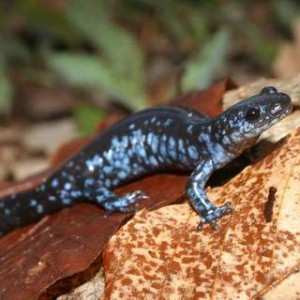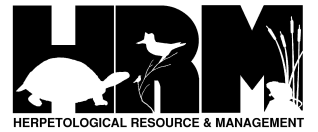Blue-spotted Salamander
Overview:
Scientific Name: Ambystoma laterale
Size: 3 – 5.5” (adult length)
Status: Quite common in woodlands, and seem to be tolerant of human habitat disturbance and fragmentation.
MDNR Wildlife Action Plan Status: Species of Greatest Conservation Need

Habitat:
Live in deciduous and coniferous forests, from moist lowland areas to drier upland forests. Most abundant in moist woodlands with sandy soils, but can also be found in open fields and backyards in suburban areas.
Adult Coloration:
Black or grayish overall with bluish spots and flecks on the sides, legs, belly, and tail, and sometimes on back. Belly black or slightly lighter than upper surfaces of body. .
Adult Characteristics:
12-14 costal grooves (grooves between rib-like ridges that run down the sides of the body). Males are slightly smaller than females and have longer, more flattened tails. During breeding males have swollen vents.
Larvae Characteristics:
Older larvae (with four legs present) may be dark brown, olive, or gray on the back with dark mottling on tail fins. Sometimes with dull yellow blotches on the back and/or a yellow stripe down each side of the back. Belly usually solid in color and lighter than back.
Species Confused With:
Small-mouthed Salamanders have very short snouts with slightly protruding lower jaw, and markings usually grayer than blue. Dark phase of Red-backed Salamander has considerably narrower body, very small legs, and small black and white spots on the belly.
References:
- Amphibians and Reptiles of the Great Lakes Region by Jim Harding
- Harding, J.H. and J.A. Holman. 1992. Michigan Frogs, Toads, and Salamanders. MSU Cooperative Extension Service and MSU Museum. Extension Bull. E-2350, 144 pp.
- Ruthven, A. G., H. B. T. Gaige, et al. 1912. The herpetology of Michigan, by Alexander B. Ruthven. Crystal Thompson and Helen Thompson; Memoranda towards a bibliography of the archaeology of Michigan, by Harlan I. Smith; prepared under the direction of Alexander G. Ruthven. Lansing, Mich., Wynkoop Hallenbeck Crawford, State Printers.
- Holman, J. A. 2012. The Amphibians and Reptiles of Michigan: A Quaternary and Recent Faunal Adventure. Detroit, Mich., Wayne State University Press.
- Conant, R., and Collins, J. T. 1998. Reptiles and Amphibians: Eastern, Central North America. Houghton Mifflin Harcourt Press.
